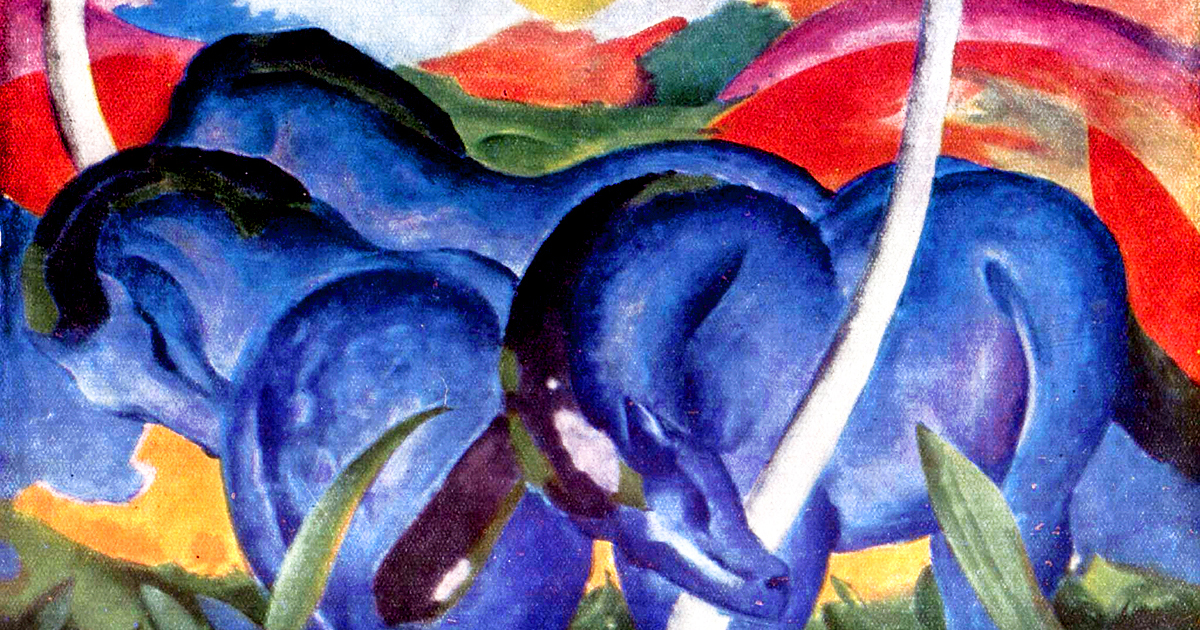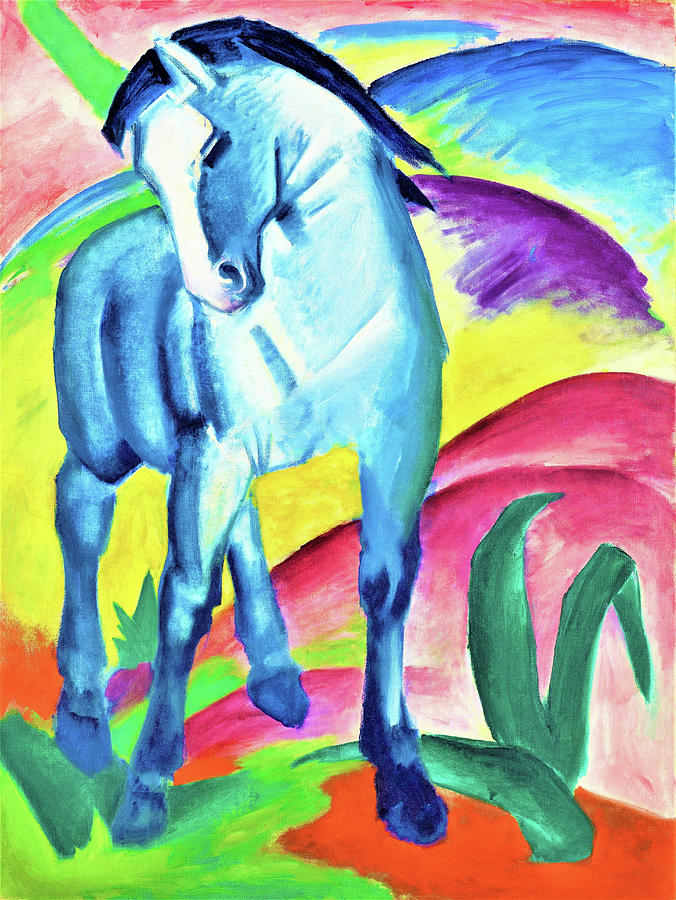
The Blue Horses of Our Destiny Artist Franz Marc, the Wisdom of
Painted a few months before Fate of the Animals, in the winter of 1913, The Tower of Blue Horses was also first exhibited at the First German Herbstsalon in the fall of that year. In 1919 it was purchased by Ldwig Justi for the National Gallery in Berlin, where it remained for the next eighteen years. It was declared "degenerate" by the Nazis.

Blue Horses (1911) by Franz Marc. Not always a fan of Expressionism
The painted tarps were military camouflage, designed to conceal artillery from aerial observation — the work of the young German painter, printmaker, and Expressionist pioneer Franz Marc (February 8, 1880-March 4, 1916), who had devoted himself to parting the veil of appearances with art in order to "look for and paint this inner, spiritual side.

Blue Horse I Franz Marc Paintings Arte su tela, Dipingere idee
The young horse in this painting does seem to exist on a more spiritual plane than our own. While Franz Marc's art often portrayed security, serenity, and spirituality, his life took a much darker turn. He was killed by a piece of shrapnel in 1916, during the assault on Verdun, despite his fear and hatred of war.

Large Blue Horses by Franz Marc Rabia Gale
The Tower of Blue Horses ( German: Der Turm der blauen Pferde) is a 1913 oil painting by the German Expressionist artist Franz Marc. It has been called one of his best works, but went missing in 1945. Description The Tower of Blue Horses was a large work, 200 by 130 centimetres (6 ft 7 in × 4 ft 3 in). [1]

Blue Horse Blaues Pferd I by Franz Marc (27 x 35) ArtToCanvas Fine
Browse & discover thousands of brands. Read customer reviews & find best sellers. Free shipping on qualified orders. Free, easy returns on millions of items.

Digital Remastered Edition Blue Horse 1 Painting by Franz Marc
Wassily Kadinsky "Blue is the masculine principle, astringent and spiritual. Yellow is the female principle, gentle, gay, and sensuous." Franz Marc Through animals, Franz depicted the "good" in the world. Nature represents a clear and realistic awareness of life.

Franz Marc Blue Horse — Spiffing Prints
This striking work depicting four blue horses is indicative of Marc's fears of the apocalypse and end of days. Looming above the viewer, the four blue horses can be taken to represent the four horsemen of the apocalypse and the bold blue colours impart a cold and foreboding feeling to this work. Repeating lines, a hallmark of Marc's work, are.

Franz Marc The Little Blue Horses Cavalli dipinti, Immagini, Pittura
In Franz Marc.seen in works such as Blue Horses (1911), in which the powerfully simplified and rounded outlines of the horses are echoed in the rhythms of the landscape background, uniting both animals and setting into a vigorous and harmonious organic whole. In this painting, as in his other mature works, Marc… Read More

Blue Horse I Art Print By Franz Marc 23.5x31.5
Marc was a sensitive man. He suffered from severe depression, and nature was something calming for him. His works embody the heightened anxieties of early 20th-century Europe, as people struggled with a rapidly changing urban world on the precipice of war. He devoted himself to the study of the anatomy of animals.

Blue Horse // Franz Marc // 1911 (60"W x 40"H x 1.5"D) iCanvasART
The Tower of Blue Horses is equally known for its aesthetic and artistic significance, and for its fascinating history. The large canvas (200x130cm) is representative of the height of Marc's artistic achievement. Marc's preparatory work is visible in The Tower of Blue Horses (1912). The artist sent this ink and gouache sketch on a postcard to the German Jewish poet Else Lasker-Schüler.

Franz Marc Picture "Blue Horse" (1912) Ars Mundi English Version
Franz Marc, Large Blue Horses, 1912, oil on canvas, 41-5/8 x 71-5/16 inches (Walker Art Center) In all of these works, Marc uses primary and secondary colors in their most intensely saturated state. Bright red or blue animals graze in vibrant pastures of reds, greens, and yellows underneath rainbow skies. While the proportions, anatomy, and.

Franz Marc Blaues Pferd (Blue Horse) II (1911) Artsy
Franz Marc's "The Large Blue Horses" [Die grossen blauen Pferden], which he painted in 1911, have adorned the walls of the Walker Art Center in Minneapolis, MN, since late 1941 when Mrs. Gilbert Walker acquired the painting from the Karl Nierendorf Gallery in New York.

Franz Marc The Small Blue Horses, 1911 at Staatsgalerie Stuttgart
Blue Horses or Die grossen blauen Pferde ( The Large Blue Horses) is a 1911 painting by German painter and printmaker Franz Marc (1880-1916). Background

Blue Horse by Franz Marc ️ Marc Franz
Blue Horse I is an oil painting by Franz Marc completed in 1911. It is one of the painter's most famous works and is part of the collection of the Städtische Galerie im Lenbachhaus in Munich.

Franz Marc. The Large Blue Horses. 1911 Franz marc, Blue horse, Horse art
Blue Horse, by Franz Marc Wassily Kandinsky wrote Concerning the Spiritual in Art in 1911, at the time Yellow Cow was painted. In that book, he emphasized the significance of the triangle as a symbol of the striving soul of the individual and humanity in general.

Marc Blaues Pferd I Monaco Franz Marc, Painted Horses, Painting
The Tower of Blue Horses. This painting is another example of Marc's apocalyptic fears. Here, he depicts four blue horses, possibly representing the Four Horsemen of the Apocalypse from the book of Revelation. The horses are stacked one above the other, on an ascending, vertical plane, eschewing depth altogether.